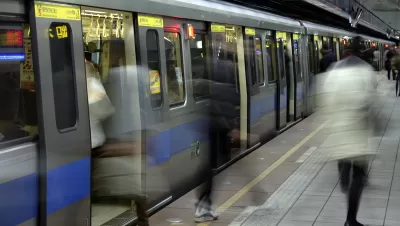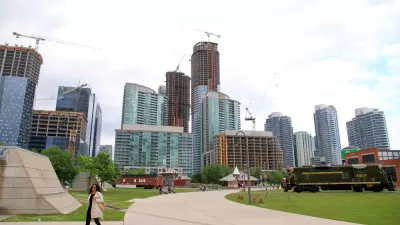This post critiques a common argument against federal support for public transit: that transit gets 20 percent of transportation spending yet has a much lower market share.

I just received a email newsletter raising the decades-old argument that public transit gets too much federal support because transit gets 20 percent of federal funding for surface transportation, but its share of trips and transportation mileage is far lower.
One obvious retort to this argument is environmental: highway spending, by encouraging automobile travel to car-dependent places, increases vehicle miles traveled (VMT), thus increasing pollution—not just greenhouse gas pollution, but also more heavily regulated types of pollution such as carbon monoxide and particulate matter. To the extent that highway spending increases such social harms, one dollar of spending may be one dollar too much, let alone the tens of billions of dollars currently devoted to roads.
In addition, highway spending can create other negative side effects: for example, where jobs track new highways but public transit does not, a "spatial mismatch" exists between the pre-highway population and jobs; population was located in more urban areas, but the highway has shifted jobs into outer suburbs and exurbs. To the extent people react to this spatial mismatch by buying cars and driving more, they have suffered additional costs caused by government action. To the extent people too poor to buy cars cannot reach work, they have suffered an even more severe cost: the loss of job opportunities.
Furthermore, the "20 percent" argument overlooks both the impact of past spending and the existence of current non-transportation policies that effectively subsidize highways and sprawl.
In the first half of the 20th century, government at all levels spent liberally on highway, but streetcars (the leading mode of public transit in most of the United States) were a private industry, which meant that government’s job was to tax and regulate it. So in many places, roads got not only the money devoted to roads, but also the implicit subsidy that government created by taxing and regulating the competition. And over the course of the 20th century, transit received far less than 20 percent of government transportation spending.
What about the past 50 years? Even if one pretends that history began with the urban transit legislation of the 1960s, government effectively subsidizes highways and sprawl in at least two major respects: zoning and education.
As a rule, zoning effectively makes sprawl easy and infill development difficult. If a developer builds a subdivision in the middle of nowhere, it will usually be able to get government permission because there will be no neighbors around to object, and municipal legislators will thus decide that the project is noncontroversial.
By contrast, if someone wants to densify an existing neighborhood, there will be plenty of neighbors around to object. As a result, community opposition will often lead cities to reject new development, since neighbors of a project vote and the project’s potential residents and customers do not. Even where infill development is allowed, cities limit density through minimum lot size, parking and setback requirements, all of which limit the number of residences, shops or offices that can be built per acre of land.
Because transit systems tend to be centered on downtown, limitations on infill development force new housing into areas that are automobile-dependent. Thus, zoning laws encourage driving and discourage transit use, thereby increasing VMT and increasing gas tax revenue. Thus, the costs of zoning are an (admittedly nonquantifiable) subway for highways.
The public education system similarly subsidizes highways. American school attendance laws require children to attend public schools in the municipality of their residence. Municipalities which are near downtown (and thus likely to have the best transit service) tend to be demographically diverse. Because the public education system tends to have difficulty educating children from disadvantaged backgrounds, such jurisdictions tend to have less prestigious public schools than car-oriented suburbs. Thus, American parents are more likely to favor car-oriented places than would be the case in a nation without government-run schools (or one where school attendance zones were drawn differently), which in turn means more driving and more gas tax revenue. This subsidy too is difficult to quantify, because not all government spending on education is on prestigious suburban schools.
In sum, government favors driving in a wide variety of ways beyond current spending on highways. As a result, the real amount of social spending and regulation favoring driving is far beyond the billions of dollars currently spent on highways, which in turn may mean that the real “spending gap” between highways and transit may exceed the 4-1 ratio between highway and transit spending.

Depopulation Patterns Get Weird
A recent ranking of “declining” cities heavily features some of the most expensive cities in the country — including New York City and a half-dozen in the San Francisco Bay Area.

California Exodus: Population Drops Below 39 Million
Never mind the 40 million that demographers predicted the Golden State would reach by 2018. The state's population dipped below 39 million to 38.965 million last July, according to Census data released in March, the lowest since 2015.

Chicago to Turn High-Rise Offices into Housing
Four commercial buildings in the Chicago Loop have been approved for redevelopment into housing in a bid to revitalize the city’s downtown post-pandemic.

Google Maps Introduces New Transit, EV Features
It will now be easier to find electric car charging stations and transit options.

Ohio Lawmakers Propose Incentivizing Housing Production
A proposed bill would take a carrot approach to stimulating housing production through a grant program that would reward cities that implement pro-housing policies.

Chicago Awarded $2M Reconnecting Communities Grant
Community advocates say the city’s plan may not do enough to reverse the negative impacts of a major expressway.
City of Costa Mesa
Licking County
Barrett Planning Group LLC
HUD's Office of Policy Development and Research
Mpact Transit + Community
HUD's Office of Policy Development and Research
City of Universal City TX
ULI Northwest Arkansas
Town of Zionsville
Write for Planetizen
Urban Design for Planners 1: Software Tools
This six-course series explores essential urban design concepts using open source software and equips planners with the tools they need to participate fully in the urban design process.
Planning for Universal Design
Learn the tools for implementing Universal Design in planning regulations.


























